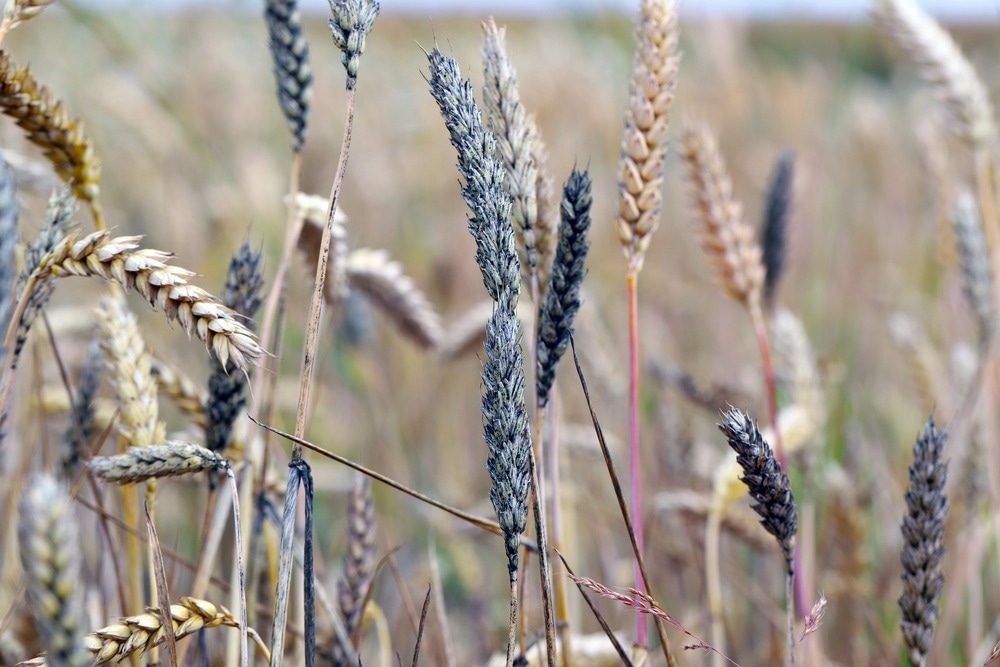In this article, we delve into the growing concern of mycotoxins and their multifaceted impact, ranging from threats to human and animal health to the economic challenges posed by contamination in global food stocks, while also highlighting management and mitigation strategies to address this critical issue.

Image Credit: Tomasz Klejdysz/Shutterstock.com
The Threat of Mycotoxins to Human and Animal Health
Global food stocks play an increasingly critical role in maintaining food security amid global climate change and growth of human populations. However, food stocks are threatened by several challenges that may affect their viability in an unpredictable and rapidly changing world. One such threat is the proliferation of mycotoxins.
Derived from the Greek work meaning “poisonous”, mycotoxins are secondary metabolites produced by fungi that typically colonize crops. Mycotoxins are toxic for humans and animals, causing diseases as well as potential death if exposed to high concentrations. There are six major groups of mycotoxins, including aflatoxins, ochratoxins, citrinins, patulins, and Fusarium toxins.
The reason for the initial contamination of crops by mycotoxins remains unclear and is likely to originate from different sources depending on the mycotoxin group. Nonetheless, mycotoxins are known to occur commonly in indoor, damp, dark environments. Although the FAO stated that only 25% of global crops are infected with mycotoxins, a 2020 study by Eskola et al. notes that this is an underestimation and that it is more likely that 60-80% of global crops are infected to some extent by mycotoxins and around 20% are above legal food safety limits.
The effects of mycotoxin exposure for humans, referred to as mycotoxicosis, are typically classified as mutagenic, carcinogenic, or genotoxic, and vary depending on the severity of exposure as well as each individual. However, mycotoxicosis can induce effects ranging from simple skin reactions to inhibition of lung functioning or death in extreme cases. In animals, further effects have been observed, including phenotypic sex changes in hens and changes in protein synthesis.
Effects of Mycotoxins on Food Stocks
Due to the adverse health effects of mycotoxicosis, the contamination of food stocks by mycotoxins can lead to food safety concerns and increased waste. Specifically, mycotoxin contamination can make food unfit for consumption, limit its production due to regulatory standards, and also spread to previously uncontaminated foods in storage. Indeed, when food is shown to be contaminated by mycotoxins, the stocks need to be destroyed if the levels are too high or to undergo mitigation processes to reduce mycotoxin loads to regulatory standards.
As a result, mycotoxins not only have health implications but also economic ones when food storage is compromised. In regions dependent on staple crops, mycotoxin contamination can lead to malnutrition and economic hardship on a wide scale. For instance, a study by Lewis et al. (2005) documented the contamination of maize by an aflatoxin, leading to the death of over 100 people and 200 others needing medical treatment.
Changes in mycotoxin levels over space and time carries health and economic significance and inform broader policies on food storage. This was considered in a 2022 study by Johns et al., in a study examining changes in fusarium head blight mycotoxins in European wheat from 2010 to 2019. Findings showed persistent mycotoxin contamination in Europe alongside changing temporal-geographical distributions characteristic of a dynamic disease.
The high fusarium blight levels detected in the study require the wheat stocks to be downgraded to prevent consequences from the consumption of contaminated wheat. However, downgrading the 5% of contaminated wheat would lead to an estimated loss of €3 billion, demonstrating the financial repercussions of mycotoxins. Therefore, mycotoxin contamination clearly poses a significant challenge to maintaining food stocks due to its impacts on food safety, security, and economic stability.
Management and Mitigation of Mycotoxins in Food Stocks
Addressing mycotoxin contamination is typically done through management strategies that prevent initial contamination and mitigation measures that limit the spread and severity of mycotoxin contamination.
Both management and mitigation of mycotoxins were discussed in a 2007 study by Dorner. The author presents the ways in which foods are screened for mycotoxins before being removed if they present a high likelihood of contamination.
The study discusses using sorting measures such as electronic colour sorting during processing that can identify mycotoxin contamination. However, such sorting can only deal with foods that are already contaminated. Preventative control measures are, therefore, of high value. This includes biological control of mycotoxins, which relies on the natural process of competitive exclusion by using a dominant population of a non-toxigenic strain to exclude toxic strains.
Preventative measures targeting initial contamination to reduce food losses have been the focus of different frameworks. One such framework was discussed by Baker et al. (2014) that advocates for the development of data repositories, a collaborative analytical infrastructure, standardized sampling procedures, and processes that link the risk assessments to initial food production. Together, these steps can ensure the effective management and mitigation of mycotoxin contamination in food stocks.
Sources
Baker, R. C., et al. (2014). Framework for Managing mycotoxin Risks in the food industry. Journal of Food Protection, 77(12), pp. 2181–2188. doi.org/10.4315/0362-028x.jfp-14-060
Dorner, J. W. (2008). Management and prevention of mycotoxins in peanuts. Food Additives & Contaminants: Part A, 25(2), pp. 203–208. doi.org/10.1080/02652030701658357
Eskola, M., et al. (2019). Worldwide contamination of food-crops with mycotoxins: Validity of the widely cited ‘FAO estimate’ of 25%. Critical Reviews in Food Science and Nutrition, 60(16), pp. 2773–2789. doi.org/10.1080/10408398.2019.1658570
Johns, L., et al. (2022). Emerging health threat and cost of Fusarium mycotoxins in European wheat. Nature Food, 3(12), pp. 1014–1019. doi.org/10.1038/s43016-022-00655-z
Lewis, L., et al. (2005). Aflatoxin Contamination of Commercial Maize Products during an Outbreak of Acute Aflatoxicosis in Eastern and Central Kenya. Environmental Health Perspectives, 113(12), pp. 1763–1767. doi.org/10.1289/ehp.7998
Vinagre, A. S., et al. (2020). Diet composition and long-term starvation do not affect crustacean hyperglycemic hormone (CHH) transcription in the burrowing crab Neohelice granulata (Dana, 1851). Comparative Biochemistry and Physiology A-molecular & Integrative Physiology, 247, p. 110738. doi.org/10.1016/j.cbpa.2020.110738
Last Updated: Sep 21, 2023